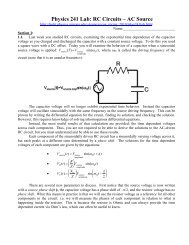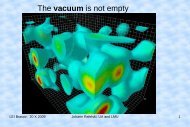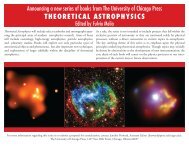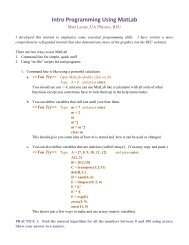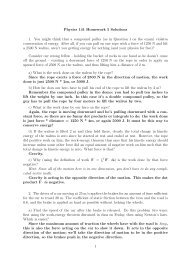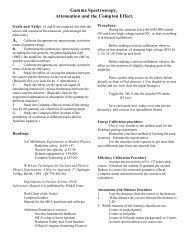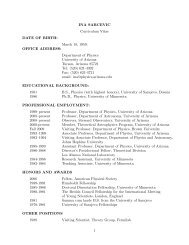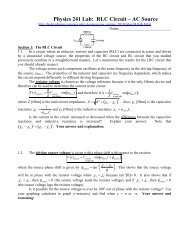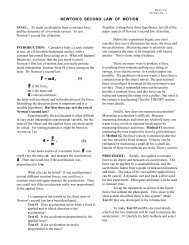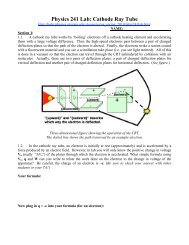Computational Methods for Parameter Estimation in Climate Models
Computational Methods for Parameter Estimation in Climate Models
Computational Methods for Parameter Estimation in Climate Models
Create successful ePaper yourself
Turn your PDF publications into a flip-book with our unique Google optimized e-Paper software.
<strong>Computational</strong> Approaches <strong>for</strong> <strong>Parameter</strong><br />
<strong>Estimation</strong> <strong>in</strong> <strong>Climate</strong> <strong>Models</strong><br />
Gabriel Huerta<br />
Department of Mathematics and Statistics<br />
University of New Mexico<br />
Jo<strong>in</strong>t with A. Villagran (UNM), C. Jackson and M.K. Sen (UT-Aust<strong>in</strong>)<br />
1
Summary Po<strong>in</strong>ts<br />
• Parametric uncerta<strong>in</strong>ties <strong>in</strong> climate model<strong>in</strong>g.<br />
• <strong>Estimation</strong> of multidimensional probability distributions.<br />
• <strong>Climate</strong> model, proxy or surrogate to a full ACGM.<br />
• Simulated Anneal<strong>in</strong>g based method (MVFSA).<br />
• Adaptive Metropolis as an alternative.<br />
• Comparisons of posterior probability distributions.
Comments on <strong>Climate</strong> <strong>Models</strong><br />
• IPCC Third Assessment Report (TAR, 2001): Global<br />
temperatures are likely to <strong>in</strong>crease by 1.1 to 6.4 ◦ C 1990-<br />
2100.<br />
• ”more comprehensive and systematic system of model<br />
analysis and diagnosis, and a Monte Carlo approach to<br />
model uncerta<strong>in</strong>ties associated with parameterizations” .<br />
• Recent progress with models of reduced complexity (Forest<br />
et al., 2000, 2001, 2002).<br />
• Perturbed physics ensembles with a general circulation<br />
model (Allen, 1999; Murphy et al, 2004; Sta<strong>in</strong><strong>for</strong>th et al.,<br />
2005; Coll<strong>in</strong>s et al., 2006).
Range of Model Hierarchies<br />
• General Circulation <strong>Models</strong>: Most demand<strong>in</strong>g.<br />
– 16 processors/24 hours to simulate 10 years of climate.<br />
• <strong>Models</strong> of Reduced Complexities: One or more spatial<br />
dimensions are elim<strong>in</strong>ated.<br />
• Surrogate or Emulator <strong>Models</strong>:<br />
– Mimics equilibrium space-time response of an Atmospheric<br />
GCM.<br />
– To test sampl<strong>in</strong>g strategies <strong>for</strong> parametric uncerta<strong>in</strong>ties.
Goals of Present Study<br />
• Estimate probability distributions <strong>for</strong> parameters <strong>in</strong> climate<br />
models.<br />
• Non-standard methods <strong>for</strong> state-of-art <strong>in</strong> the climate literature.<br />
• Improve on the calibration of the climate model.<br />
• ”appreciate the ability to detect and attribute the effects<br />
of <strong>for</strong>c<strong>in</strong>gs on paleoclimate observations”.<br />
• Bayesian approach via posterior distributions.
Surrogate <strong>Climate</strong> Model<br />
• Jackson and Broccoli (2003): ”Changes <strong>in</strong> Earth’s orbital<br />
geometry over the past 165kyears”.<br />
• Obliquity Φ ∈ (22 ◦ , 25 ◦ ), eccentricity, e ∈ (0, 0.05) and<br />
longitude of perihelion, λ ∈ (0 ◦ , 360 ◦ ).<br />
• d obs (i, j, k) is the observed surface temperature at latitude<br />
i, longitude j and season k.<br />
• Data simulated us<strong>in</strong>g Φ = 22.62, e = 0.044, λ = 75.93.<br />
• d obs (i, j, k) = g ijk (m) + η ijk , where m = (Φ, e, λ).<br />
• g is the ”surface air temperature” to a given change <strong>in</strong><br />
parameters.
• The surrogate model is<br />
g ijk (m) = A o Φ ′ + eA p cos(φ p − λ) + R ijk<br />
• Φ = Φ o + A o Φ ′ , Φ o is the mean obliquity.<br />
• Φ ′ is the deviation of obliquity from its 165,000 year<br />
mean.<br />
• φ p is the phase of the response to precessional <strong>for</strong>c<strong>in</strong>g.<br />
• R ijk is a term that is added to represent the effects of<br />
<strong>in</strong>ternal variability.<br />
• A o and A p are the sensitivity of temperature to changes<br />
<strong>in</strong> obliquity and precession respectively.
Cost or Misfit Function<br />
• Measure of the deviation from the observed data and the<br />
model.<br />
• For the climate model considered,<br />
E(m) = 1<br />
2N<br />
I∑<br />
i=1<br />
J∑<br />
j=1<br />
K∑<br />
k=1<br />
B −1<br />
ijk (d obs(i, j, k) − g ijk (m)) 2<br />
• B ijk is the variance of the observations at each grid<br />
po<strong>in</strong>t.<br />
• Other functions under study.
• The likelihood function is<br />
L(d obs |m, S) ∝ exp{−SE(m)}<br />
• S weights the significance of model-data differences.<br />
• We fixed S = 1, S = 47 and plot a profile likelihood <strong>for</strong><br />
each parameter.<br />
• Simulation values (Φ = 22.625, e = 0.043954, λ =<br />
75.93).<br />
• 20,000 po<strong>in</strong>t grid evaluation.
Likelihood functions <strong>for</strong> each orbital parameter.<br />
S=1 S=47<br />
22 23 24 25<br />
Obliquity<br />
22 23 24 25<br />
0 100 200 300<br />
Longitude of Perihelion<br />
0 100 200 300<br />
0 0.01 0.02 0.03 0.04 0.05<br />
Eccentricity<br />
0 0.01 0.02 0.03 0.04 0.05
Multiple Very Fast Simulated Anneal<strong>in</strong>g<br />
• Ingber (1989). Given a current selection m (k)<br />
i ,<br />
m (k+1)<br />
i<br />
= m (k)<br />
i<br />
• y i ∼ Cauchy distribution.<br />
+ y i (m max<br />
i<br />
− m m<strong>in</strong><br />
i )<br />
• Uses a cool<strong>in</strong>g schedule T k = T o exp(−α(k − 1) 1/d )<br />
• One accepts or rejects m (k+1)<br />
i<br />
scheme.<br />
accord<strong>in</strong>g to a Metropolis<br />
• Sen and Stoffa (1996), multiple repetitions.<br />
• Balance between estimat<strong>in</strong>g a PPD and f<strong>in</strong>d<strong>in</strong>g the<br />
global m<strong>in</strong>imum.
0<br />
Start at m and a given temperature T<br />
Evaluate E(m 0 )<br />
Metropolis<br />
Optimization method<br />
Multiple VFSA<br />
Is the number of perturbations<br />
≤ moves/temperature?<br />
NO<br />
Draw a number 0 ≤ y ≤ 1<br />
from a white distribution<br />
YES<br />
Draw a number 0 ≤ y(T) ≤ 1 from a Cauchy<br />
distribution which is temperature, T, dependent<br />
Lower temperature, T<br />
Compute new model components<br />
new 0 max m<strong>in</strong><br />
m = m + y(m - m )<br />
i i i i<br />
new<br />
Evaluate E(m )<br />
YES<br />
0 new<br />
m = m<br />
new 0<br />
Is DE=E(m ) - E(m ) < 0?<br />
NO<br />
new<br />
Accept m with a<br />
probability exp(-DE/T)<br />
YES<br />
0<br />
Has m changed <strong>in</strong> previous ntarget perturbations?<br />
STOP
Adaptive <strong>Methods</strong>: S<strong>in</strong>gle Component AM<br />
• m i,k−1 = (m (0)<br />
i , ..., m (k−1)<br />
i ) are the sampled values <strong>for</strong><br />
the i-th parameter.<br />
• Variance equation V (k)<br />
i<br />
= s d V (m i,k−1 ) + s d ɛ where<br />
V (m i,k−1 ) = 1<br />
k − 1<br />
• Updat<strong>in</strong>g m (k)<br />
i at iteration k,<br />
– z i ∼ N(m (k−1)<br />
i , V (k)<br />
i )<br />
∑k−1<br />
r=0<br />
(m (r)<br />
i − m i ) 2
– Accept z i with probability<br />
m<strong>in</strong><br />
(<br />
1, π(m(k) 1<br />
π(m (k)<br />
1<br />
, ..., m(k) i−1 , z i, m (k−1)<br />
i+1 , ..., m (k−1)<br />
, ..., m(k)<br />
i−1 , m(k−1) i<br />
• We produce samples π(m, S|d obs ).<br />
d<br />
)<br />
, ..., m (k−1)<br />
d<br />
)<br />
• ”Flat” priors on orbital <strong>for</strong>c<strong>in</strong>g parameters. S ∼ Gamma<br />
distribution (α 0 = 552.25,β 0 = 11.75).<br />
• π(m|S, d obs ) is sampled through SC-AM.<br />
• π(S|m, d obs ) is a Gamma α ∗ = α 0 and β ∗ = β 0 +<br />
E(m (k) ).<br />
)
Adaptive <strong>Methods</strong>: FAM. (Haario et al. 2001)<br />
• All parameters are sampled at once.<br />
• z ∼ q t (·|m (0) , ..., m (t−1) ),<br />
• z is accepted with probability,<br />
(<br />
α(m (t−1) , z) = m<strong>in</strong> 1,<br />
)<br />
π(z)<br />
,<br />
π(m (t−1) )<br />
• q t (·) is a multivariate Gaussian with mean m (t−1) and<br />
covariance matrix C t .<br />
• Recursively, C t = s d C t−1 + s d ɛI d , where s d > 0 and<br />
ɛ > 0
Adaptive <strong>Methods</strong>: DRAM (Haario and Mira 2006)<br />
• Comb<strong>in</strong>es Delayed Rejection (DR) and Adaptive<br />
Metropolis.<br />
• In DR, propose a second state move if first move was<br />
rejected.<br />
• The process can be iterated <strong>for</strong> a fixed or random number.<br />
• DR comb<strong>in</strong>es different proposals.<br />
• May use <strong>for</strong> <strong>in</strong>itial period (burn-<strong>in</strong>).<br />
• The DR method uses rejected values without los<strong>in</strong>g properties.
Bivariate scatter plots of orbital <strong>for</strong>c<strong>in</strong>g parameters.<br />
FAM<br />
SCAM<br />
DRAM<br />
MVFSA<br />
METSA<br />
300<br />
300<br />
300<br />
300<br />
300<br />
Longitude of<br />
Perihelion<br />
200<br />
100<br />
200<br />
100<br />
200<br />
100<br />
200<br />
100<br />
200<br />
100<br />
0<br />
22 23 24 25<br />
Obliquity<br />
0<br />
22 23 24 25<br />
Obliquity<br />
0<br />
22 23 24 25<br />
Obliquity<br />
0<br />
22 23 24 25<br />
Obliquity<br />
0<br />
22 23 24 25<br />
Obliquity<br />
0.05<br />
0.05<br />
0.05<br />
0.05<br />
0.05<br />
Eccentricity<br />
0.04<br />
0.03<br />
0.02<br />
0.01<br />
0.04<br />
0.03<br />
0.02<br />
0.01<br />
0.04<br />
0.03<br />
0.02<br />
0.01<br />
0.04<br />
0.03<br />
0.02<br />
0.01<br />
0.04<br />
0.03<br />
0.02<br />
0.01<br />
0<br />
22 23 24 25<br />
Obliquity<br />
0<br />
22 23 24 25<br />
Obliquity<br />
0<br />
22 23 24 25<br />
Obliquity<br />
0<br />
22 23 24 25<br />
Obliquity<br />
0<br />
22 23 24 25<br />
Obliquity<br />
0.05<br />
0.05<br />
0.05<br />
0.05<br />
0.05<br />
Eccentricity<br />
0.04<br />
0.03<br />
0.02<br />
0.01<br />
0.04<br />
0.03<br />
0.02<br />
0.01<br />
0.04<br />
0.03<br />
0.02<br />
0.01<br />
0.04<br />
0.03<br />
0.02<br />
0.01<br />
0.04<br />
0.03<br />
0.02<br />
0.01<br />
0<br />
0 100 200 300<br />
Longitude of<br />
Perihelion<br />
0<br />
0 100 200 300<br />
Longitude of<br />
Perihelion<br />
0<br />
0 100 200 300<br />
Longitude of<br />
Perihelion<br />
0<br />
0 100 200 300<br />
Longitude of<br />
Perihelion<br />
0<br />
0 100 200 300<br />
Longitude of<br />
Perihelion
Root Mean Square (RMS) Probability Error<br />
• For every parameter θ, :<br />
RMS i (θ) = ||P rob (θ)<br />
i<br />
− P rob (θ)<br />
π ||<br />
• P rob (θ)<br />
i is a vector of ”b<strong>in</strong> probabilities” estimated from<br />
output at iteration i.<br />
• P rob (θ)<br />
i<br />
probability vector under target.<br />
• RMS goes to zero as i goes to <strong>in</strong>f<strong>in</strong>ity.<br />
• P rob (θ)<br />
i<br />
from a basel<strong>in</strong>e method.
Comparison <strong>for</strong> Obliquity <strong>Parameter</strong>.<br />
1.8<br />
FAM<br />
25<br />
Quantile <strong>Estimation</strong> − 97.5%<br />
SCAM<br />
1.6<br />
DRAM<br />
MVFSA<br />
24.5<br />
1.4<br />
METSA<br />
1.2<br />
24<br />
1<br />
0.8<br />
Obliquity<br />
23.5<br />
0.6<br />
23<br />
0.4<br />
0.2<br />
22.5<br />
FAM<br />
SCAM<br />
DRAM<br />
MVFSA<br />
METSA<br />
0<br />
22 22.5 23 23.5 24 24.5 25<br />
Obliquity<br />
22<br />
0 10000 20000 30000 40000 50000<br />
Iterations<br />
25<br />
Obliquity<br />
25<br />
20<br />
FAM<br />
SCAM<br />
DRAM<br />
MVFSA<br />
METSA<br />
24.5<br />
24<br />
RMS<br />
15<br />
10<br />
Obliquity<br />
23.5<br />
23<br />
5<br />
22.5<br />
0<br />
0 10000 20000 30000 40000 50000<br />
Iterations<br />
22<br />
FAM SCAM DRAM MVFSA METSA
Comparison <strong>for</strong> Longitude of Perihelion <strong>Parameter</strong>.<br />
0.06<br />
FAM<br />
350<br />
Quantile <strong>Estimation</strong> − 97.5%<br />
SCAM<br />
0.05<br />
DRAM<br />
MVFSA<br />
300<br />
METSA<br />
0.04<br />
0.03<br />
0.02<br />
Longitude of Perihelion<br />
250<br />
200<br />
150<br />
100<br />
FAM<br />
SCAM<br />
DRAM<br />
MVFSA<br />
METSA<br />
0.01<br />
50<br />
0<br />
0 50 100 150 200 250 300 350<br />
Longitude of Perihelion<br />
0<br />
0 10000 20000 30000 40000 50000<br />
Iterations<br />
0.35<br />
Longitude of Perihelion<br />
350<br />
RMS<br />
0.3<br />
0.25<br />
0.2<br />
0.15<br />
0.1<br />
FAM<br />
SCAM<br />
DRAM<br />
MVFSA<br />
METSA<br />
Longitude of Perihelion<br />
300<br />
250<br />
200<br />
150<br />
100<br />
0.05<br />
50<br />
0<br />
0 10000 20000 30000 40000 50000<br />
Iterations<br />
0<br />
FAM SCAM DRAM MVFSA METSA
Comparison <strong>for</strong> Eccentricity <strong>Parameter</strong>.<br />
100<br />
FAM<br />
Quantile <strong>Estimation</strong> − 97.5%<br />
90<br />
SCAM<br />
DRAM<br />
0.05<br />
80<br />
MVFSA<br />
METSA<br />
0.045<br />
70<br />
0.04<br />
60<br />
50<br />
40<br />
30<br />
20<br />
Eccentricity<br />
0.035<br />
0.03<br />
0.025<br />
0.02<br />
0.015<br />
0.01<br />
FAM<br />
SCAM<br />
DRAM<br />
MVFSA<br />
METSA<br />
10<br />
0.005<br />
0<br />
0 0.005 0.01 0.015 0.02 0.025 0.03 0.035 0.04 0.045 0.05<br />
Eccentricity<br />
0<br />
0 10000 20000 30000 40000 50000<br />
Iterations<br />
800<br />
Eccentricity<br />
FAM<br />
0.05<br />
700<br />
SCAM<br />
DRAM<br />
0.045<br />
600<br />
MVFSA<br />
METSA<br />
0.04<br />
0.035<br />
RMS<br />
500<br />
400<br />
300<br />
Eccentricity<br />
0.03<br />
0.025<br />
0.02<br />
200<br />
100<br />
0.015<br />
0.01<br />
0.005<br />
0<br />
0 10000 20000 30000 40000 50000<br />
Iterations<br />
0<br />
FAM SCAM DRAM MVFSA METSA
Autocorrelation function of orbital <strong>for</strong>c<strong>in</strong>g parameters.<br />
FAM<br />
SCAM<br />
DRAM<br />
MVFSA<br />
METSA<br />
0.8<br />
0.8<br />
0.8<br />
0.8<br />
0.8<br />
Sample ACF<br />
Obliquity<br />
0.6<br />
0.4<br />
0.2<br />
0<br />
0.6<br />
0.4<br />
0.2<br />
0<br />
0.6<br />
0.4<br />
0.2<br />
0<br />
0.6<br />
0.4<br />
0.2<br />
0<br />
0.6<br />
0.4<br />
0.2<br />
0<br />
−0.2<br />
0 50 100<br />
−0.2<br />
0 50 100<br />
−0.2<br />
0 50 100<br />
−0.2<br />
0 50 100<br />
−0.2<br />
0 50 100<br />
Sample ACF<br />
Longitude of Perihelion<br />
1<br />
0.8<br />
0.6<br />
0.4<br />
0.2<br />
0<br />
−0.2<br />
0 50 100<br />
1<br />
0.8<br />
0.6<br />
0.4<br />
0.2<br />
0<br />
−0.2<br />
0 50 100<br />
1<br />
0.8<br />
0.6<br />
0.4<br />
0.2<br />
0<br />
−0.2<br />
0 50 100<br />
1<br />
0.8<br />
0.6<br />
0.4<br />
0.2<br />
0<br />
−0.2<br />
0 50 100<br />
1<br />
0.8<br />
0.6<br />
0.4<br />
0.2<br />
0<br />
−0.2<br />
0 50 100<br />
1<br />
1<br />
1<br />
1<br />
1<br />
0.8<br />
0.8<br />
0.8<br />
0.8<br />
0.8<br />
Sample ACF<br />
Eccentricity<br />
0.6<br />
0.4<br />
0.2<br />
0<br />
0.6<br />
0.4<br />
0.2<br />
0<br />
0.6<br />
0.4<br />
0.2<br />
0<br />
0.6<br />
0.4<br />
0.2<br />
0<br />
0.6<br />
0.4<br />
0.2<br />
0<br />
−0.2<br />
0 50 100<br />
Lag<br />
−0.2<br />
0 50 100<br />
Lag<br />
−0.2<br />
0 50 100<br />
Lag<br />
−0.2<br />
0 50 100<br />
Lag<br />
−0.2<br />
0 50 100<br />
Lag
Appraisal of a few <strong>for</strong>ward evaluations<br />
• Impossible to evaluate methods us<strong>in</strong>g thousands of iterations.<br />
• We evaluate the methods just with 500 iterations of the<br />
climate model.<br />
• 500 is approximately the number of experiments currently<br />
per<strong>for</strong>med on the CAM model by the Institute of<br />
Geophysics at the University of Texas-Aust<strong>in</strong>.
Bivariate scatter plots with 500 iterations.<br />
FAM<br />
SCAM<br />
DRAM<br />
MVFSA<br />
METSA<br />
Longitude of Perihelion<br />
300<br />
200<br />
100<br />
0<br />
22 23 24 25<br />
Obliquity<br />
300<br />
200<br />
100<br />
0<br />
22 23 24 25<br />
Obliquity<br />
300<br />
200<br />
100<br />
0<br />
22 23 24 25<br />
Obliquity<br />
300<br />
200<br />
100<br />
0<br />
22 23 24 25<br />
Obliquity<br />
300<br />
200<br />
100<br />
0<br />
22 23 24 25<br />
Obliquity<br />
0.05<br />
0.05<br />
0.05<br />
0.05<br />
0.05<br />
Eccentricity<br />
0.04<br />
0.03<br />
0.02<br />
0.01<br />
0.04<br />
0.03<br />
0.02<br />
0.01<br />
0.04<br />
0.03<br />
0.02<br />
0.01<br />
0.04<br />
0.03<br />
0.02<br />
0.01<br />
0.04<br />
0.03<br />
0.02<br />
0.01<br />
0<br />
22 23 24 25<br />
Obliquity<br />
0<br />
22 23 24 25<br />
Obliquity<br />
0<br />
22 23 24 25<br />
Obliquity<br />
0<br />
22 23 24 25<br />
Obliquity<br />
0<br />
22 23 24 25<br />
Obliquity<br />
0.05<br />
0.05<br />
0.05<br />
0.05<br />
0.05<br />
Eccentricity<br />
0.04<br />
0.03<br />
0.02<br />
0.01<br />
0.04<br />
0.03<br />
0.02<br />
0.04<br />
0.03<br />
0.02<br />
0.01<br />
0.04<br />
0.03<br />
0.02<br />
0.01<br />
0.04<br />
0.03<br />
0.02<br />
0.01<br />
0<br />
0.01<br />
0 100 200 300 0 100 200 300<br />
Longitude of Perihelion Longitude of Perihelion<br />
0<br />
100 200 300<br />
Longitude of Perihelion<br />
0<br />
0 100 200 300<br />
Longitude of Perihelion<br />
0<br />
0 100 200 300<br />
Longitude of Perihelion
Histograms with 500 iterations.<br />
2<br />
FAM<br />
2<br />
SCAM<br />
2<br />
DRAM<br />
2<br />
MVFSA<br />
2<br />
METSA<br />
1.5<br />
1.5<br />
1.5<br />
1.5<br />
1.5<br />
1<br />
1<br />
1<br />
1<br />
1<br />
0.5<br />
0.5<br />
0.5<br />
0.5<br />
0.5<br />
0<br />
22 23 24<br />
Obliquity<br />
0<br />
22 23 24<br />
Obliquity<br />
0<br />
22 23 24<br />
Obliquity<br />
0<br />
22 23 24<br />
Obliquity<br />
0<br />
22 23 24<br />
Obliquity<br />
0.06<br />
0.06<br />
0.06<br />
0.06<br />
0.06<br />
0.04<br />
0.04<br />
0.04<br />
0.04<br />
0.04<br />
0.02<br />
0.02<br />
0.02<br />
0.02<br />
0.02<br />
0<br />
50 100 150<br />
Longitude of Perihelion<br />
0<br />
50 100 150<br />
Longitude of Perihelion<br />
0<br />
50 100 150<br />
Longitude of Perihelion<br />
0<br />
50 100 150<br />
Longitude of Perihelion<br />
0<br />
50 100 150<br />
Longitude of Perihelion<br />
80<br />
80<br />
80<br />
80<br />
80<br />
60<br />
60<br />
60<br />
60<br />
60<br />
40<br />
40<br />
40<br />
40<br />
40<br />
20<br />
20<br />
20<br />
20<br />
20<br />
0<br />
0 0.02 0.04<br />
Eccentricity<br />
0<br />
0 0.02 0.04<br />
Eccentricity<br />
0<br />
0 0.02 0.04<br />
Eccentricity<br />
0<br />
0 0.02 0.04<br />
Eccentricity<br />
0<br />
0 0.02 0.04<br />
Eccentricity
Comparative estimation with 500 evaluations.<br />
Method E(m ∗ ) Φ 2.5% Φ 97.5% λ 2.5% λ 97.5% e 2.5% e 97.5%<br />
FAM 0.8411 22.6817 22.7813 0.2248 3.4413 0.0101 0.0331<br />
SCAM 0.1912 22.1644 23.1309 60.6625 91.5434 0.0312 0.0495<br />
DRAM 0.1943 22.1665 22.9816 62.7528 141.1550 0.0113 0.0491<br />
MVFSA 0.2019 22.1595 24.5072 18.3329 311.9383 0.0089 0.0482<br />
METSA 0.2029 22.0631 24.2744 38.6806 353.6220 0.0029 0.0481<br />
• Optimal cost function values comparable except <strong>for</strong><br />
FAM.<br />
• 95 % probability <strong>in</strong>tervals <strong>for</strong> MVFSA are wide compared<br />
to SCAM and DRAM.
Relevance of S parameter.<br />
1.8<br />
1.6<br />
1.4<br />
1.2<br />
1<br />
0.8<br />
0.6<br />
0.4<br />
0.2<br />
0<br />
22 22.5 23 23.5 24 24.5 25<br />
Obliquity<br />
0.05<br />
0.045<br />
0.04<br />
0.035<br />
0.03<br />
0.025<br />
0.02<br />
0.015<br />
0.01<br />
0.005<br />
0<br />
0 100 200 300<br />
Longitude of Perihelion<br />
100<br />
90<br />
80<br />
70<br />
60<br />
50<br />
40<br />
30<br />
20<br />
10<br />
0<br />
0 0.01 0.02 0.03 0.04 0.05<br />
Eccentricity<br />
25<br />
24.5<br />
350<br />
300<br />
0.05<br />
0.045<br />
0.04<br />
Obliquity<br />
24<br />
23.5<br />
23<br />
22.5<br />
Longitude of<br />
Perihelion<br />
250<br />
200<br />
150<br />
100<br />
50<br />
Eccentricity<br />
0.035<br />
0.03<br />
0.025<br />
0.02<br />
0.015<br />
0.01<br />
0.005<br />
22<br />
0<br />
0<br />
S<br />
Non <strong>in</strong><strong>for</strong>mative prior<br />
S<br />
Non <strong>in</strong><strong>for</strong>mative prior<br />
S<br />
Non <strong>in</strong><strong>for</strong>mative prior
F<strong>in</strong>al Thoughts<br />
• MVFSA is a fast method to detect optima but has biases.<br />
• DRAM, or SCAM provided nearly identical estimates of<br />
the marg<strong>in</strong>al PPD.<br />
• MVFSA has similar modes with broader credible <strong>in</strong>tervals.<br />
• Results ma<strong>in</strong>ly apply to unimodal posteriors.<br />
• Model configurations that reflect uncerta<strong>in</strong>ties <strong>in</strong> model<br />
development.<br />
* NSF support grant OCE-0415251
References<br />
• Forest, C., M. R. Allen, P. H. Stone, and A. P. Sokolov, 2000, Constra<strong>in</strong><strong>in</strong>g<br />
uncerta<strong>in</strong>ties <strong>in</strong> climate models us<strong>in</strong>g climate change detection<br />
techniques, Geophys. Res. Lett., 27(4), 569-572.<br />
• Forest, C., M. R. Allen, A. P. Sokolov, and P. H. Stone, 2001, Constra<strong>in</strong><strong>in</strong>g<br />
climate model properties us<strong>in</strong>g optimal f<strong>in</strong>gerpr<strong>in</strong>t detection<br />
methods, <strong>Climate</strong> Dynamics, 18, 277-295.<br />
• Forest, C., P. H. Stone, A. P. Sokolov, M. R. Allen, and M. D. Webster,<br />
2002, Quantify<strong>in</strong>g uncerta<strong>in</strong>ties <strong>in</strong> climate system properties<br />
with the use of recent climate observations, Science, 295, 113-117.<br />
• Haario, H., La<strong>in</strong>e, M., Mira, A. and Saksman, E., 2006, DRAM:<br />
Efficient adaptive MCMC, Statistics and Comput<strong>in</strong>g, 16, 339-354.
• Haario, H., Saksman, E., Tammimen, J., 2001, An Adaptive<br />
Metropolis algorithm, Bernoulli, 7, 223-242.<br />
• Intergovernmental Panel on <strong>Climate</strong> Change, 2001, 2007 Third Assessment<br />
Report, http://www.ipcc.ch/pub/reports.htm<br />
• Ingber, L., 1989, Very fast simulated re-anneal<strong>in</strong>g, Mathematical<br />
<strong>Computational</strong> Modell<strong>in</strong>g, 12, 967-973.<br />
• Jackson, C. and Broccoli, A., 2003, Orbital <strong>for</strong>c<strong>in</strong>g of Arctic climate:<br />
mechanisms of climate response and implications <strong>for</strong> cont<strong>in</strong>ental<br />
glaciation, <strong>Climate</strong> Dynamics, 21, 539-557.<br />
• Jackson, C.S., Sen, M.K., Huerta, G., Deng, Y., and Bowman, K.P.,<br />
2008, Error Reduction and Convergence <strong>in</strong> <strong>Climate</strong> Prediction, (Submitted<br />
to Journal of <strong>Climate</strong>).
• Jackson, C., Sen, M. and Stoffa, P., 2004, An Efficient Stochastic<br />
Bayesian Approach to Optimal <strong>Parameter</strong> and Uncerta<strong>in</strong>ty <strong>Estimation</strong><br />
<strong>for</strong> <strong>Climate</strong> Model Predictions, Journal of <strong>Climate</strong>, 17, 2828-<br />
2840.<br />
• Sansó, B., Forest, C.E. and Zantedeschi, D., 2008, Inferr<strong>in</strong>g <strong>Climate</strong><br />
System Properties Us<strong>in</strong>g a Computer Model (with discussion),<br />
Bayesian Analysis, 3, 1, 1-62 .<br />
• Villagran, A., Huerta, G., Jackson, C, and Sen, M.K, 2008 <strong>Computational</strong><br />
<strong>Methods</strong> <strong>for</strong> <strong>Parameter</strong> <strong>Estimation</strong> <strong>in</strong> <strong>Climate</strong> <strong>Models</strong>,<br />
(Submitted to Bayesian Analysis).




